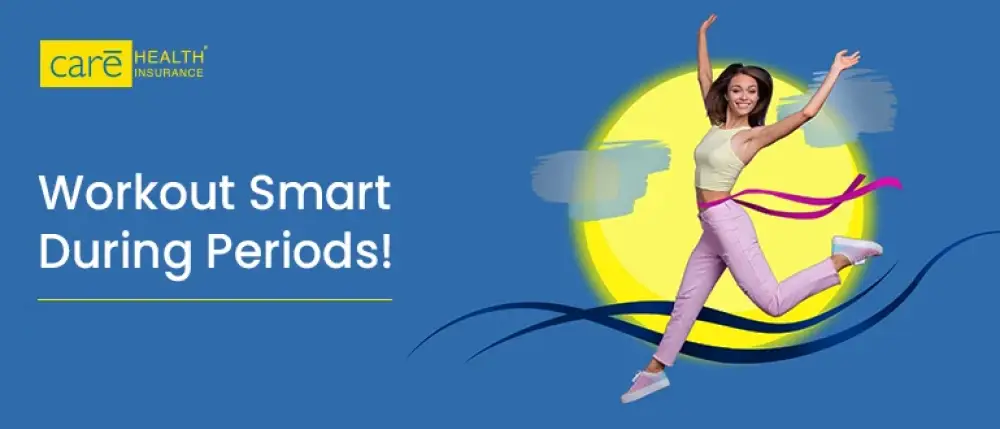Subscribe to get weekly insights
Always stay up to date with our newest articles sent direct to your inbox
Published on 17 Nov, 2025
Updated on 17 Nov, 2025
2 Views
7 min Read

Written by Jagriti Chakraborty
Reviewed by Akhil Pillai
favorite0Like
favoriteBe the First to Like
Have you ever asked your grandma if it's okay to work out on your period? Chances are, she’d laugh at the thought and recount how women in her days were advised to take rest, avoid strenuous tasks and take it easy. For her, exercise and menstruation simply didn’t go together. Physical activity was seen as too much strain on a body already drained by menstruation.
However, modern science has deviated from the script. Fitness experts say working out during your period can be beneficial, especially with mild activities like yoga, stretching, or light cardio. These exercises in periods can be a game-changer for menstrual pain, increasing energy, and lifting your spirit, making those tough days more comfortable and manageable. So, is it a game-changer or a blunder? Let’s see.
Many people hesitate to exercise during their periods, often fearing cramps, fatigue, and a heavy physical toll. Concerns about unexpected leaks or running on empty energy can make exercise seem more stressful than beneficial. Correct? Here’s a fresh way to look at these points.
Feeling overwhelmed by these challenges? Stick around because science has some unexpected ways to help you stay active with ease and confidence.
For your grandma, exercise and menstruation might seem like a mismatch, but even a little movement actually works like a charm. Let’s find out how:
Did you know you can protect your cardiovascular health with Care Heart? It’s curated explicitly for those individuals living with cardiac ailments or recovering from heart surgery. With this plan, you receive medical coverage for ICU stays, ambulance services, automatic recharge, and an annual cardiac health check-up, helping you stay protected while maintaining a healthy heart.
The Grandma Fitness Plan: Earlier, “pocha” or floor cleaning wasn’t just about a shiny floor. It secretly worked like a full-body workout: squatting, twisting, and stretching while scrubbing the floor boosted blood circulation, kept their bodies much more flexible, and, unknowingly, supported a healthier, more regular flow. Ironically, it wasn’t an optional workout; it was a daily, non-negotiable household chore.
Your cycle doesn’t have to put your fitness routine on hold. However, you must understand that not all workouts are created equal. Choosing the right exercise can be a game-changer; selecting the wrong one can do more harm than good. It’s time to find the perfect period-friendly workouts.
Did you know: Your dedication to fitness is also appreciated by your health insurance with Be-Fit Benefit. It allows unlimited visits to affiliated gyms during the policy year.
Period-Proof Dance: Belly dance is considered a period-friendly dance for women during their menstrual cycle. Thanks to its flowing movements, which not only tone your core but also offer relief and enjoyment, making it therapeutic during your challenging days.
Physical activities during your periods often come with mixed feelings- one day you’re drained, while on others it rewards you with comfort and a boost of positivity with easy-flow movements. However, the perks go far beyond overcoming heaviness and dullness. The following are essential factors to consider when working out during periods.
Also Read: 7 Smart Hydration Hacks You’ll Want to Try in 2025
Taking it easy was grandma’s rule during periods, and there’s a profound wisdom in that.
Modern science highlights that mindful movement can improve overall well-being; therefore, it seems wise to consider both perspectives. Here’s a closer look.
The moment has arrived to merge the best of both worlds. Respect grandma’s advice, but also add a pinch of modern science to identify your perfect period-friendly routine.
Periods are here only for a few days each month, but your health deserves attention for a lifetime. Exercise and menstruation help you manage your discomfort for a few days each month. Still, your individual health insurance policy protects your future by covering unexpected illness, surprise hospital visits, and ongoing care.
Start supporting your body today and cover your health for years. Enjoy your periods, stay empowered!
Disclaimer: All plan features, benefits, coverage and claims underwriting are subject to policy terms and conditions. Kindly refer to the brochure, sales prospectus and policy documents carefully.
favoriteBe the First to Like
Thyroid : मामूली नहीं हैं महिलाओं में थायराइड होना, जानें इसके लक्षण और घरेलू उपचार Vipul Tiwary in Diseases
शुगर कंट्रोल कैसे करे? जानें, डायबिटीज में क्या खाना चाहिए Vipul Tiwary in Health & Wellness
हाई ब्लड प्रेशर को तुरंत कंट्रोल कैसे करें? देखें इसके उपाय Vipul Tiwary in Diseases
पैरों में दर्द किस कमी से होता है? जानें, इसके घरेलू इलाज Vipul Tiwary in Health Insurance Articles
What are the Benefits of Drinking Hot Water? Sejal Singhania in Home Remedies
Yes, however, gentle to moderate exercise is advisable during periods, as it can boost mood, ease cramps, maintain healthy blood flow, and keep you energetic all day long.
Strenuous exercises that can overexert your body should be strictly avoided during periods, particularly when pain is intense.
It is better to balance both. Gentle stretching can relieve discomfort, yet taking a break when you feel exhausted is equally valuable.
Not really. Skipping exercise can reduce blood flow, leaving you bloated, sluggish, and uncomfortable throughout the day.
Always stay up to date with our newest articles sent direct to your inbox
Loading...